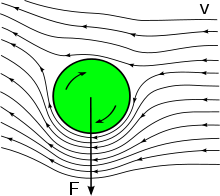Topspin
This article possibly contains original research. (August 2009) |

Template:Tennis shots In sports, in particular racquet sports, topspin is a property of a shot where the ball rotates as if rolling in the same direction as it is moving. Topspin on a shot imparts a downward force that causes the ball to drop, due to its interaction with the air (see Magnus effect). It can be generated by hitting the ball with an up-and-forward swing, with the racquet facing below the direction it is moving. A topspin shot is the opposite of the slice; topspin itself is the opposite of backspin.
Physical explanation

One way of explaining the Magnus effect is that - because of the rotation and the fact that air acts as a viscous or "sticky" substance on the surface of the ball, a stream of air in the wake of the ball is being ejected upwards. As a reaction to this, the ball is pushed downwards.
Often Bernoulli's principle is used to explain the topspin effect, as the difference in speed between ball surface and air is greater on the top of the ball. Since there is more air friction on the top of the ball compared to the bottom, this differential causes greater pressure on the top of the ball resulting in the ball being pushed down.
Competitive utility
The topspin shot is very effective on hard surfaces. The ball spins forward and descends toward the ground quicker, so it can be hit with more force compared to another type of shot.
On most court surfaces, topspin also makes the ball bounce higher. As a result, it is often used on clay or "soft" court surfaces which have a naturally higher bounce, in order to make the ball harder for the opponent to hit. An opponent with a one-handed backhand is especially vulnerable to a topspin shot because it is difficult to hit a high ball with a one-handed backhand.
The topspin shot is primarily used by tennis players as either a "safe shot" or rally ball, or it can also be used to construct a point. For example, a player may hit three topspin shots crosscourt, and then on the fourth shot hit a flat ball or a slice down the line to set him/herself up to win the point. One athlete that utilizes the shot with great success is Rafael Nadal.


In tennis because of a net being in the middle of the court, using topspin will increase the player's consistency. Topspin also allows a player a greater margin of error. Because topspin brings the ball down toward the ground quicker, a player can hit the ball higher over the net, thus increasing the margin of error. Hitting low to high as the player approaches the contact point will impart lift. Keeping the racket face (the strings) slightly closed from perpendicular will impart the topspin to the ball that the player wants.
Other sports
In Snooker, Pool and Billiards, players use topspin to keep the cue ball moving, including after it hits other balls. They get top spin by hitting the cue against the top of the ball.
In Golf shots may also have topspin, although this is nearly always the undesirable consequence of a topped shot.
In Cricket, a topspinner is a type of delivery bowled by a wrist spin or finger spin bowler with top spin, so the ball falls earlier and faster than normal. As a result, the ball drops shorter and bounces higher than might otherwise be anticipated by the batsman.
In Baseball the curveball, a type of pitch which usually has downward movement, is thrown in such a way as to put topspin on the ball.
In competitive Table tennis, effective command of topspin is indispensable, not only in order to be able to execute an attack shot counter to a backspin ball, but also in order to be able to execute a speed shot when the ball is already lower than the net.
In Soccer topspin is used with volleys to strike the ball forcefully while keeping it in play. It is also used on freekicks and other shots to make the ball dip over a wall, or simply to keep it on target.
In Volleyball topspin is used during spiking and serving to allow players to hit the ball harder, while ensuring that the ball remains in play in the opponent's court. Topspin also stabilises the ball during its flight, allowing for more accurate serving.
